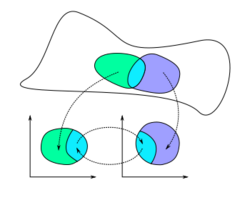Atlas (topology)
 From HandWiki - Reading time: 4 min
From HandWiki - Reading time: 4 min
In mathematics, particularly topology, an atlas is a concept used to describe a manifold. An atlas consists of individual charts that, roughly speaking, describe individual regions of the manifold. If the manifold is the surface of the Earth, then an atlas has its more common meaning. In general, the notion of atlas underlies the formal definition of a manifold and related structures such as vector bundles and other fiber bundles.
Charts
The definition of an atlas depends on the notion of a chart. A chart for a topological space M (also called a coordinate chart, coordinate patch, coordinate map, or local frame) is a homeomorphism [math]\displaystyle{ \varphi }[/math] from an open subset U of M to an open subset of a Euclidean space. The chart is traditionally recorded as the ordered pair [math]\displaystyle{ (U, \varphi) }[/math].
Formal definition of atlas
An atlas for a topological space [math]\displaystyle{ M }[/math] is an indexed family [math]\displaystyle{ \{(U_{\alpha}, \varphi_{\alpha}) : \alpha \in I\} }[/math] of charts on [math]\displaystyle{ M }[/math] which covers [math]\displaystyle{ M }[/math] (that is, [math]\displaystyle{ \bigcup_{\alpha\in I} U_{\alpha} = M }[/math]). If for some fixed n, the image of each chart is an open subset of n-dimensional Euclidean space, then [math]\displaystyle{ M }[/math] is said to be an n-dimensional manifold.
The plural of atlas is atlases, although some authors use atlantes.[1][2]
An atlas [math]\displaystyle{ \left( U_i, \varphi_i \right)_{i \in I} }[/math] on an [math]\displaystyle{ n }[/math]-dimensional manifold [math]\displaystyle{ M }[/math] is called an adequate atlas if the following conditions hold:
- The image of each chart is either [math]\displaystyle{ \R^n }[/math] or [math]\displaystyle{ \R_+^n }[/math], where [math]\displaystyle{ \R_+^n }[/math] is the closed half-space,
- [math]\displaystyle{ \left( U_i \right)_{i \in I} }[/math] is a locally finite open cover of [math]\displaystyle{ M }[/math], and
- [math]\displaystyle{ M = \bigcup_{i \in I} \varphi_i^{-1}\left( B_1 \right) }[/math], where [math]\displaystyle{ B_1 }[/math] is the open ball of radius 1 centered at the origin.
Every second-countable manifold admits an adequate atlas.[3] Moreover, if [math]\displaystyle{ \mathcal{V} = \left( V_j \right)_{j \in J} }[/math] is an open covering of the second-countable manifold [math]\displaystyle{ M }[/math], then there is an adequate atlas [math]\displaystyle{ \left( U_i, \varphi_i \right)_{i \in I} }[/math] on [math]\displaystyle{ M }[/math], such that [math]\displaystyle{ \left( U_i\right)_{i \in I} }[/math] is a refinement of [math]\displaystyle{ \mathcal{V} }[/math].[3]
Transition maps
A transition map provides a way of comparing two charts of an atlas. To make this comparison, we consider the composition of one chart with the inverse of the other. This composition is not well-defined unless we restrict both charts to the intersection of their domains of definition. (For example, if we have a chart of Europe and a chart of Russia, then we can compare these two charts on their overlap, namely the European part of Russia.)
To be more precise, suppose that [math]\displaystyle{ (U_{\alpha}, \varphi_{\alpha}) }[/math] and [math]\displaystyle{ (U_{\beta}, \varphi_{\beta}) }[/math] are two charts for a manifold M such that [math]\displaystyle{ U_{\alpha} \cap U_{\beta} }[/math] is non-empty. The transition map [math]\displaystyle{ \tau_{\alpha,\beta}: \varphi_{\alpha}(U_{\alpha} \cap U_{\beta}) \to \varphi_{\beta}(U_{\alpha} \cap U_{\beta}) }[/math] is the map defined by [math]\displaystyle{ \tau_{\alpha,\beta} = \varphi_{\beta} \circ \varphi_{\alpha}^{-1}. }[/math]
Note that since [math]\displaystyle{ \varphi_{\alpha} }[/math] and [math]\displaystyle{ \varphi_{\beta} }[/math] are both homeomorphisms, the transition map [math]\displaystyle{ \tau_{\alpha, \beta} }[/math] is also a homeomorphism.
More structure
One often desires more structure on a manifold than simply the topological structure. For example, if one would like an unambiguous notion of differentiation of functions on a manifold, then it is necessary to construct an atlas whose transition functions are differentiable. Such a manifold is called differentiable. Given a differentiable manifold, one can unambiguously define the notion of tangent vectors and then directional derivatives.
If each transition function is a smooth map, then the atlas is called a smooth atlas, and the manifold itself is called smooth. Alternatively, one could require that the transition maps have only k continuous derivatives in which case the atlas is said to be [math]\displaystyle{ C^k }[/math].
Very generally, if each transition function belongs to a pseudogroup [math]\displaystyle{ \mathcal G }[/math] of homeomorphisms of Euclidean space, then the atlas is called a [math]\displaystyle{ \mathcal G }[/math]-atlas. If the transition maps between charts of an atlas preserve a local trivialization, then the atlas defines the structure of a fibre bundle.
See also
- Smooth atlas
- Smooth frame
References
- ↑ Jost, Jürgen (11 November 2013). Riemannian Geometry and Geometric Analysis. Springer Science & Business Media. ISBN 9783662223857. https://books.google.com/books?id=VRz2CAAAQBAJ&pg=PA1. Retrieved 16 April 2018.
- ↑ Giaquinta, Mariano; Hildebrandt, Stefan (9 March 2013). Calculus of Variations II. Springer Science & Business Media. ISBN 9783662062012. https://books.google.com/books?id=_ZT_CAAAQBAJ&pg=PA418. Retrieved 16 April 2018.
- ↑ 3.0 3.1 Kosinski, Antoni (2007). Differential manifolds. Mineola, N.Y: Dover Publications. ISBN 978-0-486-46244-8. OCLC 853621933.
- Dieudonné, Jean (1972). "XVI. Differential manifolds". Treatise on Analysis. Pure and Applied Mathematics. III. Academic Press.
- Lee, John M. (2006). Introduction to Smooth Manifolds. Springer-Verlag. ISBN 978-0-387-95448-6.
- Loomis, Lynn; Sternberg, Shlomo (2014). "Differentiable manifolds". Advanced Calculus (Revised ed.). World Scientific. pp. 364–372. ISBN 978-981-4583-93-0.
- Sepanski, Mark R. (2007). Compact Lie Groups. Springer-Verlag. ISBN 978-0-387-30263-8.
- Husemoller, D (1994), Fibre bundles, Springer, Chapter 5 "Local coordinate description of fibre bundles".
External links
- Atlas by Rowland, Todd
 |
 KSF
KSF
